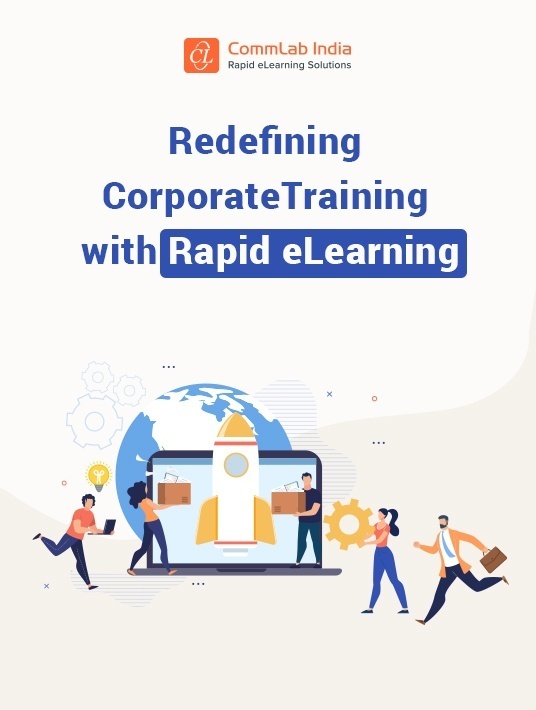Reduce Training Costs With Blended Learning And Speed Up eLearning Content Development
"I don’t have enough time in the classroom to teach all that is required!" Sounds familiar? This is the complaint of many classroom trainers who are constrained by limitations of time, scheduling, logistics, etc.

Is there a solution to this problem? The good news is there is a solution: the effective use of technology in the form of blended learning solutions.
What Is Blended Learning?
Blended learning is a combination of classroom training and online learning, offering the best of both worlds. It offers learners the opportunity to take self-paced learning and also interact face-to-face with instructors. Self-paced learning can take the form of eLearning, microlearning, online manuals, and job aids.
The learning landscape is undergoing rapid transformation, all because of blended learning. Where previously learners were restricted to formal training programs in the classroom or lengthy eLearning courses, now they can explore additional avenues for learning in the form of informal training programs [1], both inside and outside the classroom.
The rigid boundaries of classroom training are fast disappearing thanks to blended learning solutions. Logically speaking, one would think blended learning solutions will cost more compared to training that is strictly restricted to the classroom, but this need not be the case. When you opt for rapid eLearning, you save both time and money.
Smart Tips To Reduce Training Cost And Accelerate Development With Blended Learning
Here are some practical tips to save training costs and complete eLearning development faster with blended learning.
1. Ask The Right Questions
Asking the right questions will help you come up with a foolproof plan for blended learning implementation [2]. Some of the questions that require clear answers would be:
- Do we have the right infrastructure in place to roll out blended learning?
- How will blended learning help overcome problems with classroom training?
- Which blended learning model should we opt for?
- Will learners be using their own mobile devices? If yes, is there a BYOD policy in place?
It requires careful planning and buy-in from your IT support team to integrate online and offline learning experiences into blended learning. Asking the right questions is one way of ensuring you use your training budget effectively for a successful training solution.
2. Identify The Objectives
The learning objectives of your blended learning program should act like a roadmap [3]. When the learning objectives aren’t clear or if the content is irrelevant, the training fails to make its mark. It’s like a chain reaction where one wrong move ends in disaster for the entire training program.
On the other hand, when the learning objectives of your blended learning program are clear, your content automatically becomes more relevant and you get a clear idea of what can be converted to eLearning. You don’t waste time and effort on irrelevant content or interactivities that do nothing to help learners achieve the objectives.
3. Determine The Online And Classroom Components
Deciding what component of the training goes online and what needs to be taught in the classroom is an important decision in blended learning design.
Example
| One of our clients from the healthcare industry discovered they were spending a considerable amount of their training budget on classroom training. Though imparting product knowledge was the main purpose of the training, a lot of time and effort went into educating new hires on basic information.
With a blended learning solution in place, our client managed to cut down classroom training from a week to 3 days. eLearning was used for training on pre-requisites—basic essential information before taking the product training—before the classroom training. After the classroom training, microlearning modules were used as refresher training. |
As training managers, one of the key decisions you’ll be required to take is to decide on the blend. Here are some quick pointers to help you decide which components are best dealt with in the classroom, and which online.
Choose classroom training for topics which:
- Require face-to-face interactions for effective training
Leadership training, sales, and behavioral training are a few examples, as they require interaction between the instructor and the learners in order to be effective.
- Deal with topics that have a high-risk, high impact on the business
The classroom can be used to facilitate a deep learning experience.
- Need hands-on practice
Choose rapid eLearning to:
- Deliver pre-requisite training before classroom training
- Enhance efficiencies with role-based training
- Provide self-assessment opportunities to learners
- Provide Just-In-Time training
When you have a clear plan of what to include in the classroom and online components of your blend, you can be sure that the outcomes of your training program are going to be better and fetch the results that you’re looking for.
4. Leverage Templates Offered By Rapid Authoring Tools
One of the biggest advantages of leveraging rapid eLearning for blended solutions is the use of templates. Authoring tools come with ready-to-use templates that can be quickly customized to meet your project requirements. You can have templates for the GUI, introductory slide, summary, assessments, and interactions, and what’s wonderful is that these templates can be reused across courses.
Apart from being easy to use and update, eLearning templates offer a consistent look and feel throughout the course and speed up development time. If you’re considering a rapid eLearning curriculum, it’s easier to ensure compliance with branding guidelines with the effective use of templates [4].
5. Personalize Learning By Role
One question that we’ve often heard from stakeholders is on the extent of personalization offered by blended learning. Is it even possible to offer specific information that applies to an employee group or a department without prolonging the development time and delaying training completion?
For instance, employee training on ERP software should be designed differently according to their roles and usage of the software.
Examples
|
Conclusion
More and more organizations are recognizing the need to shift to informal and experiential learning experiences. For such organizations, blended learning offers the perfect medium to deliver training that fits the way people learn as it makes it easier to tailor the learning experience according to the learners’ needs.
Not just rapid eLearning, blended learning can also make use of microlearning assets that can be used before, during, and after training. Download the eBook Redefining Corporate Training With Rapid eLearning and join the webinar to get the chance to incorporate modern learning strategies into your training quickly and easily.
References:
[1] Harness the Power of Informal Workplace Learning to Enhance Training
[2] Implementing Blended Learning? Be Prepared for these 3 Challenges!
[3] Online Training with a Purpose: The Magic of Learning Objectives
[4] 10 Stunning E-learning Templates of Storyline 360 that Reduce Development Effort










